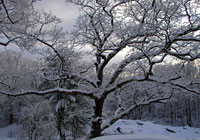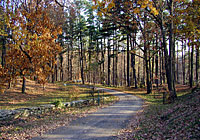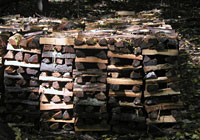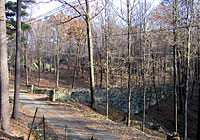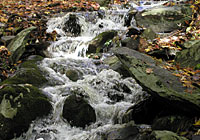 A place to relax | |
The Romantic LandscapeThere are several outdoor 'rooms' that are characteristic of the Romantic landscape tradition. Some are original to the Vanderbilt ownership and others created or enhanced by the current landscape restoration. The forest area is densely wooded, but contains many specimen trees from over 100 years ago, some overgrown by the tangle of vines, wild roses, or bittersweet. The landscape immediately surrounding the house is deliberately formal and incorporates a Chinese peony garden, herb garden, perennial garden, and rock gardens. A terrace garden, fence and arbor enclose the pool area. Across from the tennis court, another garden is anticipated, similar in concept and layout to the 'Shakespeare Garden' in Central Park. The garden will take advantage of the dramatic rock formations behind the tennis court. This site provides excellent sunlight, drainage, and wind protection. As you move farther away from the house, the landscape becomes deliberately less formal. It transitions to a woodland landscape at the end of the lawn, where a hydrangea bed was installed in 2005. Beyond that, among the tall pines, are various woodland plants, hellebores, myrtle, Virginia creeper, vines, etc. The 150 ft. tall stand of white pines is near the end of its natural life; many trees and stumps have been cut and removed, 15 to 20 or more, in recent years. The stone bridge was restored by a group of 6 stone masons from South America who spent the summer of 2002 gathering stone and rebuilding the bridge from grade. About 20 feet of the vertical profile of this massive structure was hidden by debris from years of illegal dumping. The land itself was in legal dispute for over 15 years and as such had no clear owner. The landscape beyond the ridge has many massive rock formations. There are other features: stone walls, an orchard, extensive carriage trails, a hemlock forest, a meadow, marsh area, pond, several streams, and a large antique steel water tower, the original source of water for the Vanderbilt Mansion. Deer, fox, coyotes, owls, wild turkeys, hawks, and other wildlife inhabit the property. Over the years, the abuse to this land has been considerable. For example, the site was frequently used for illegal hunting and dumping construction debris. Although the land is currently zoned for high-density residential development, a Conservation Easement assures that it will never be used for that purpose. | |

